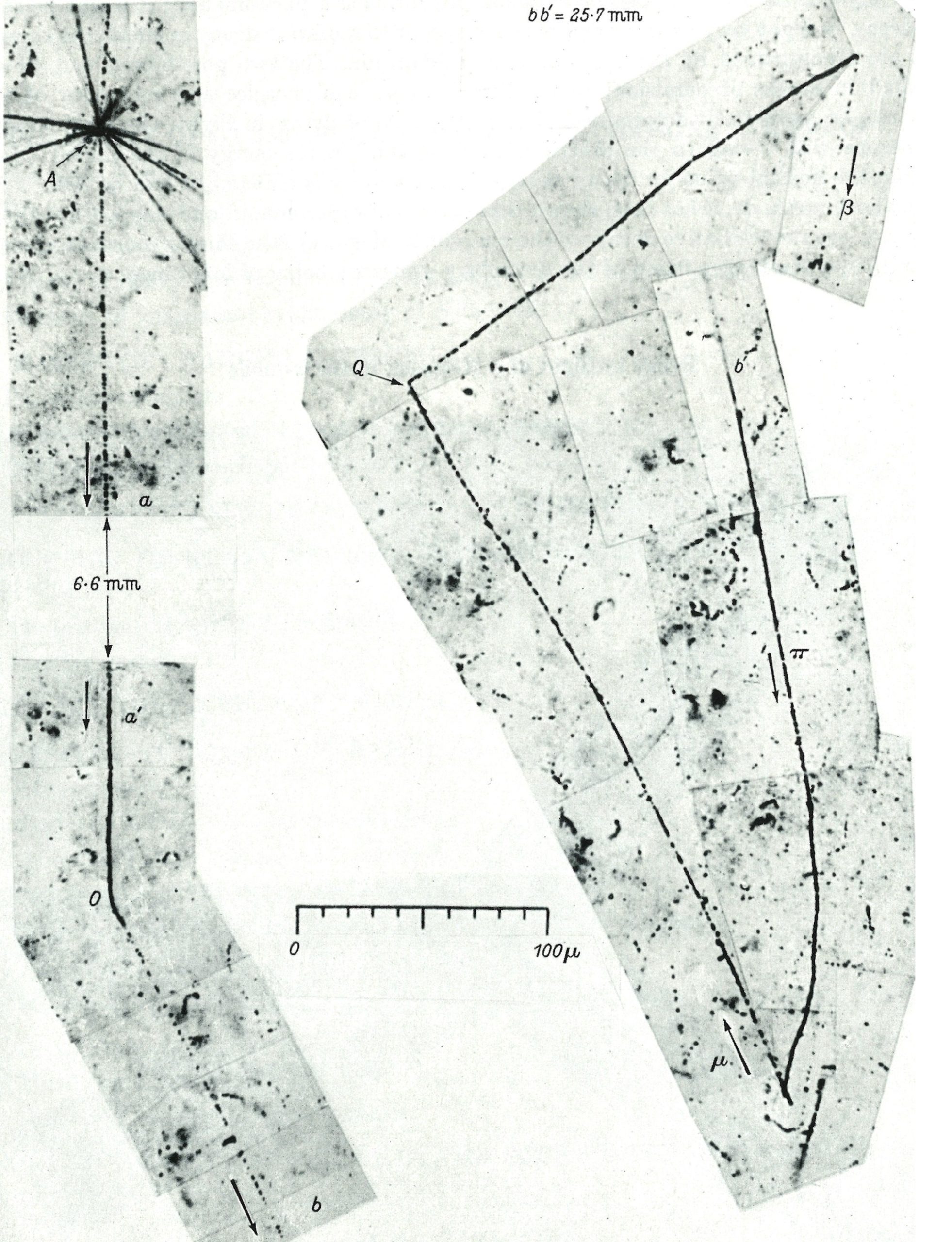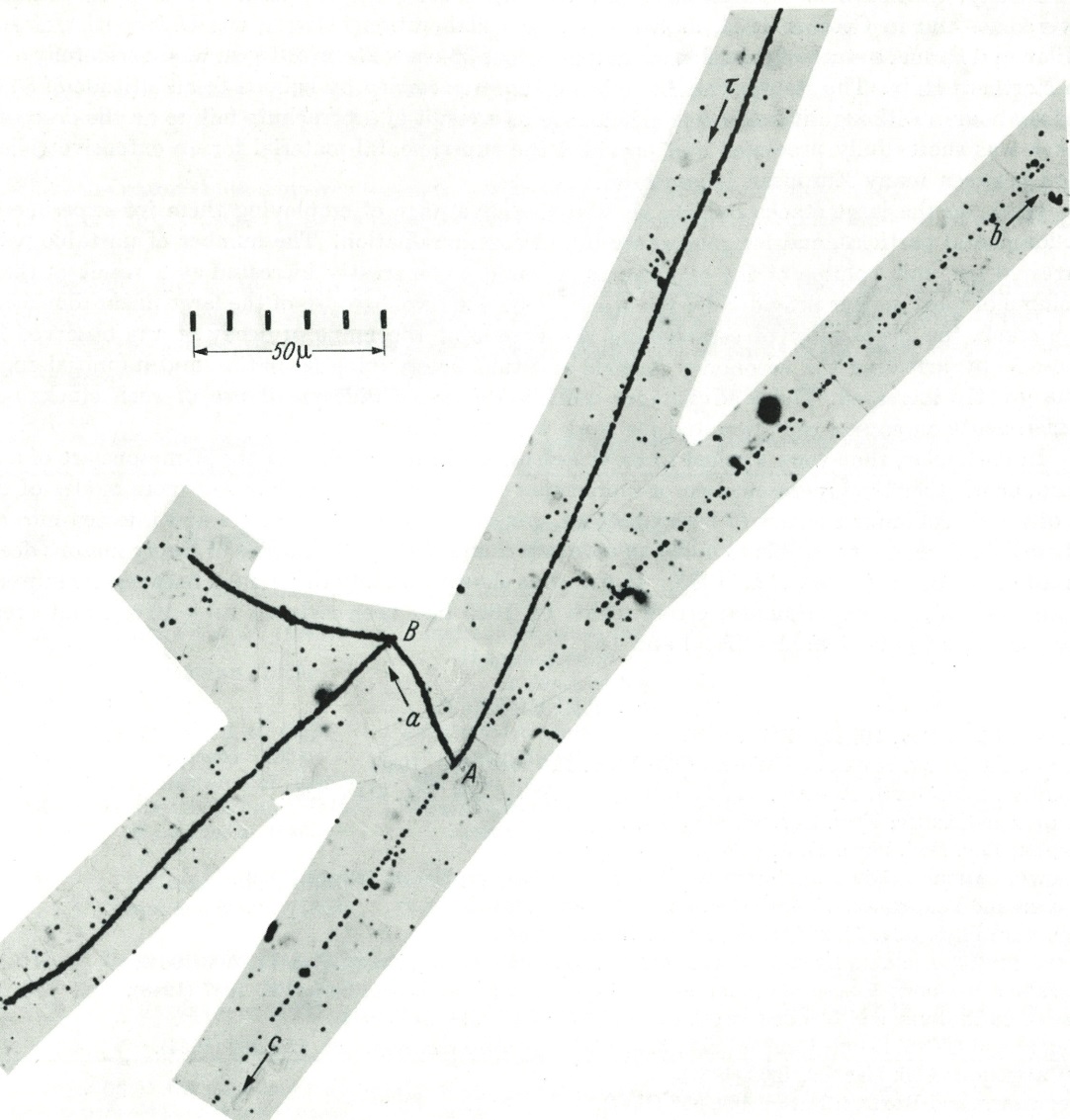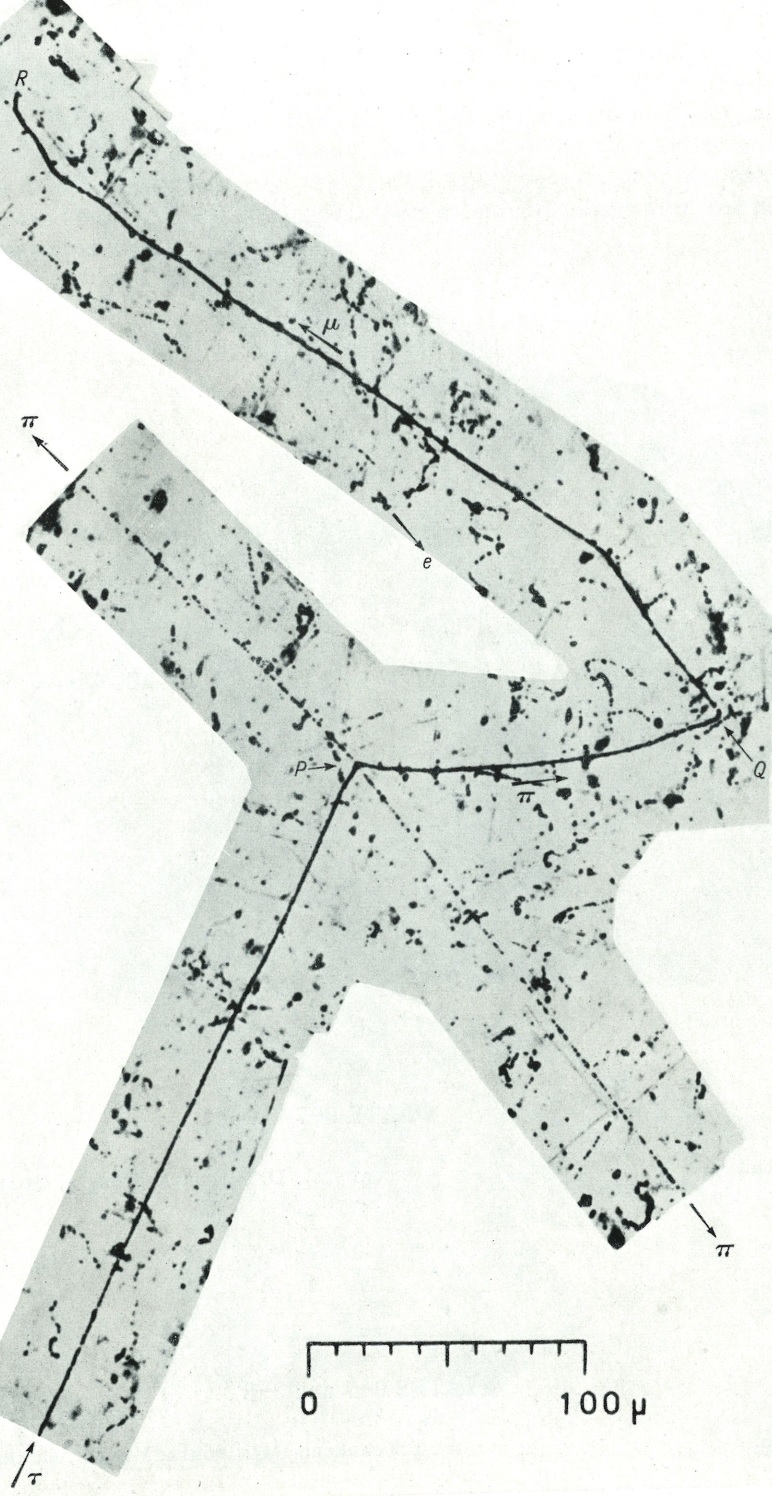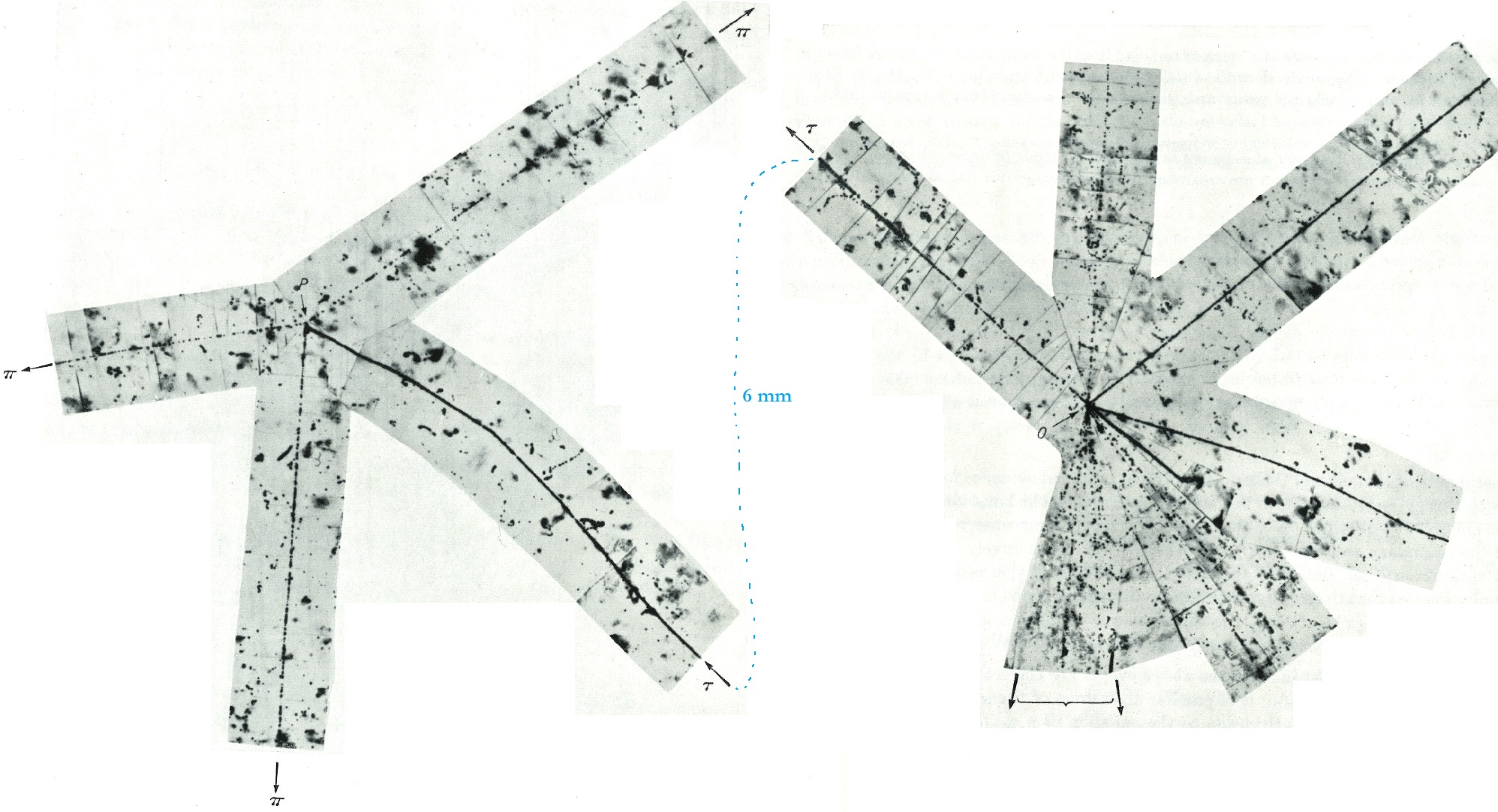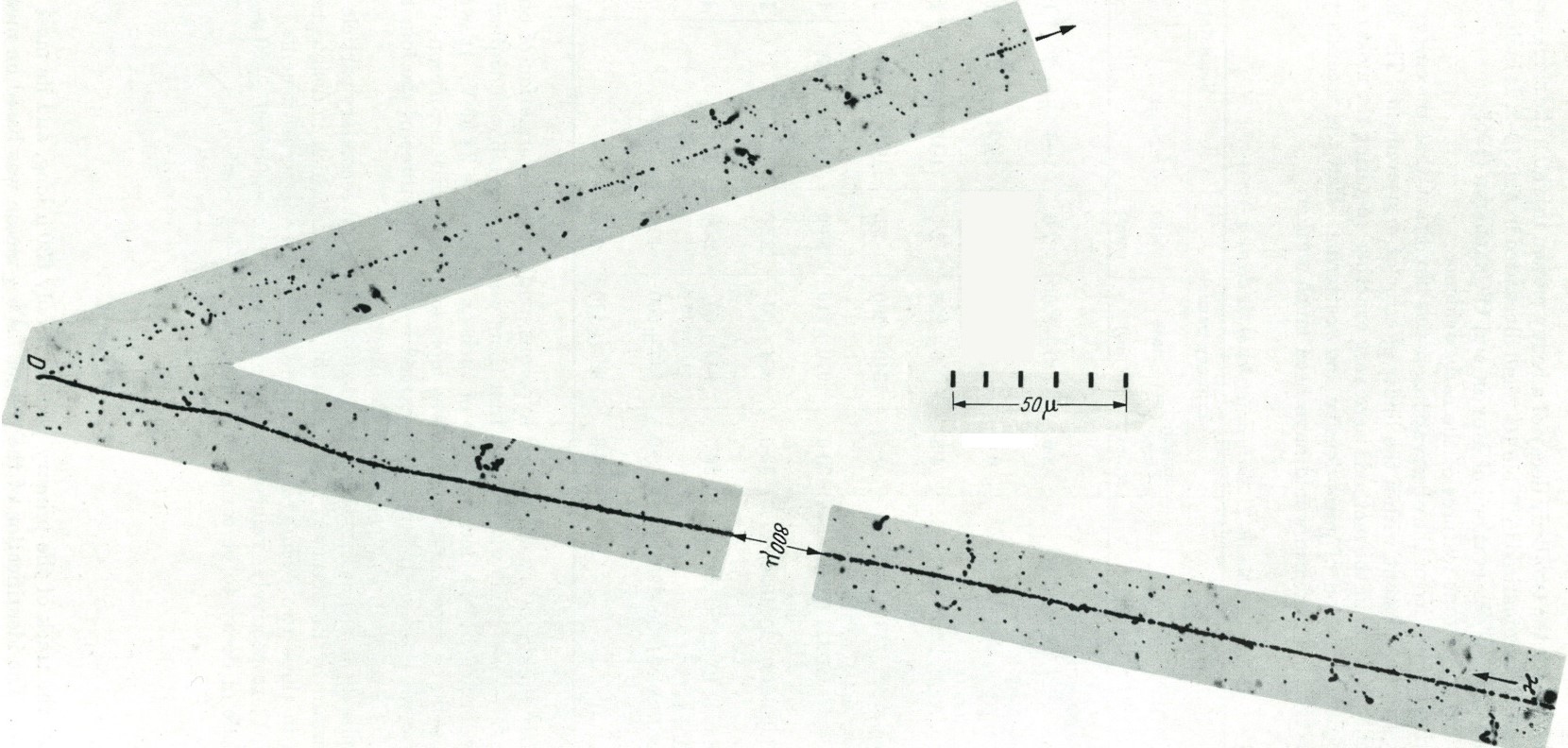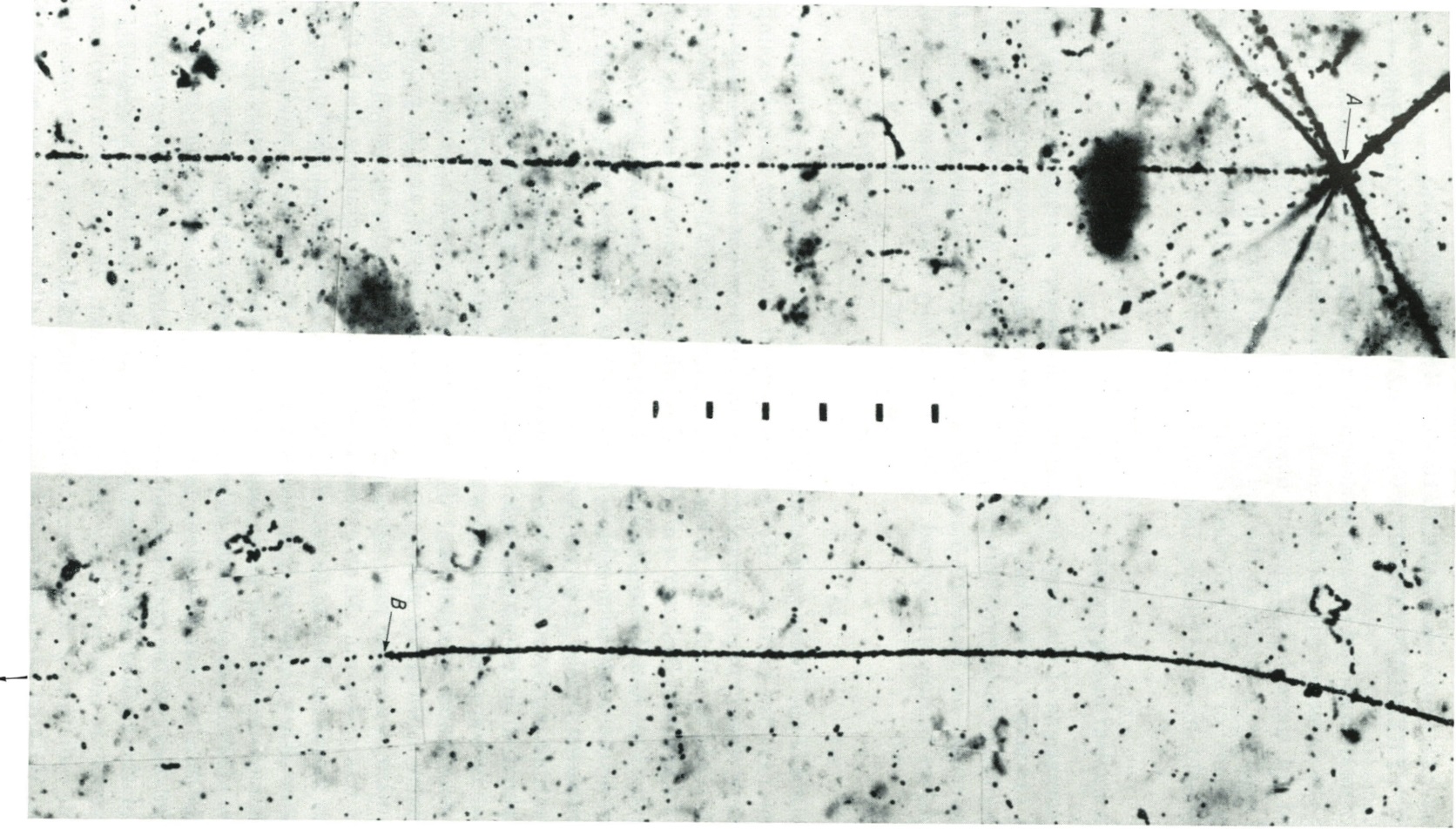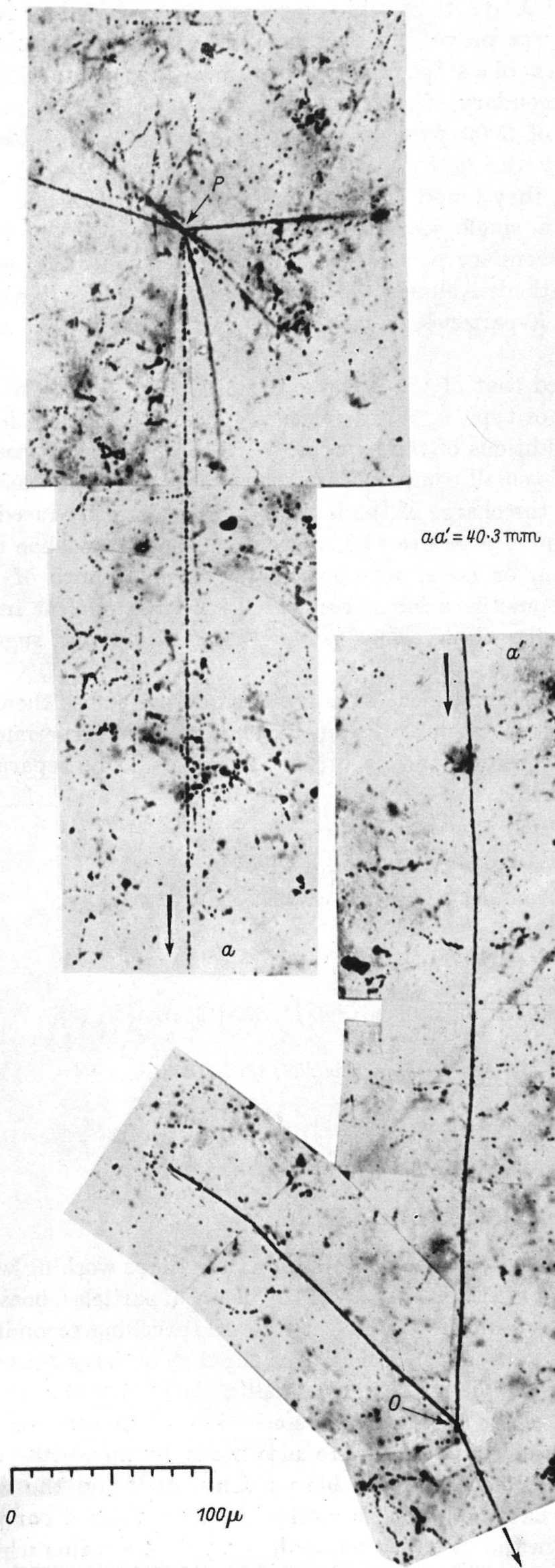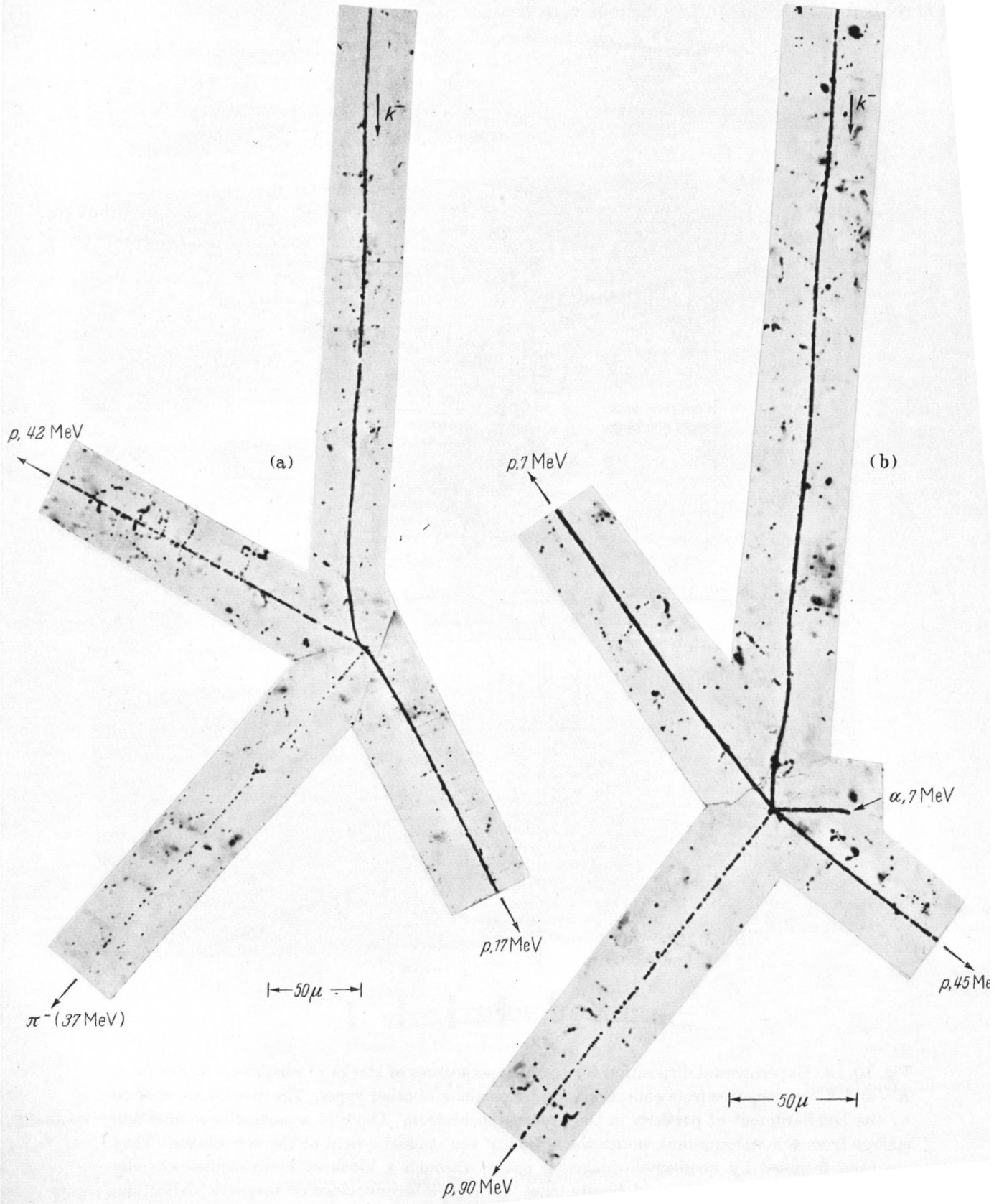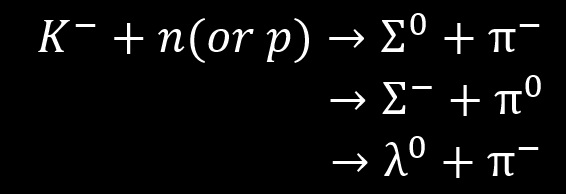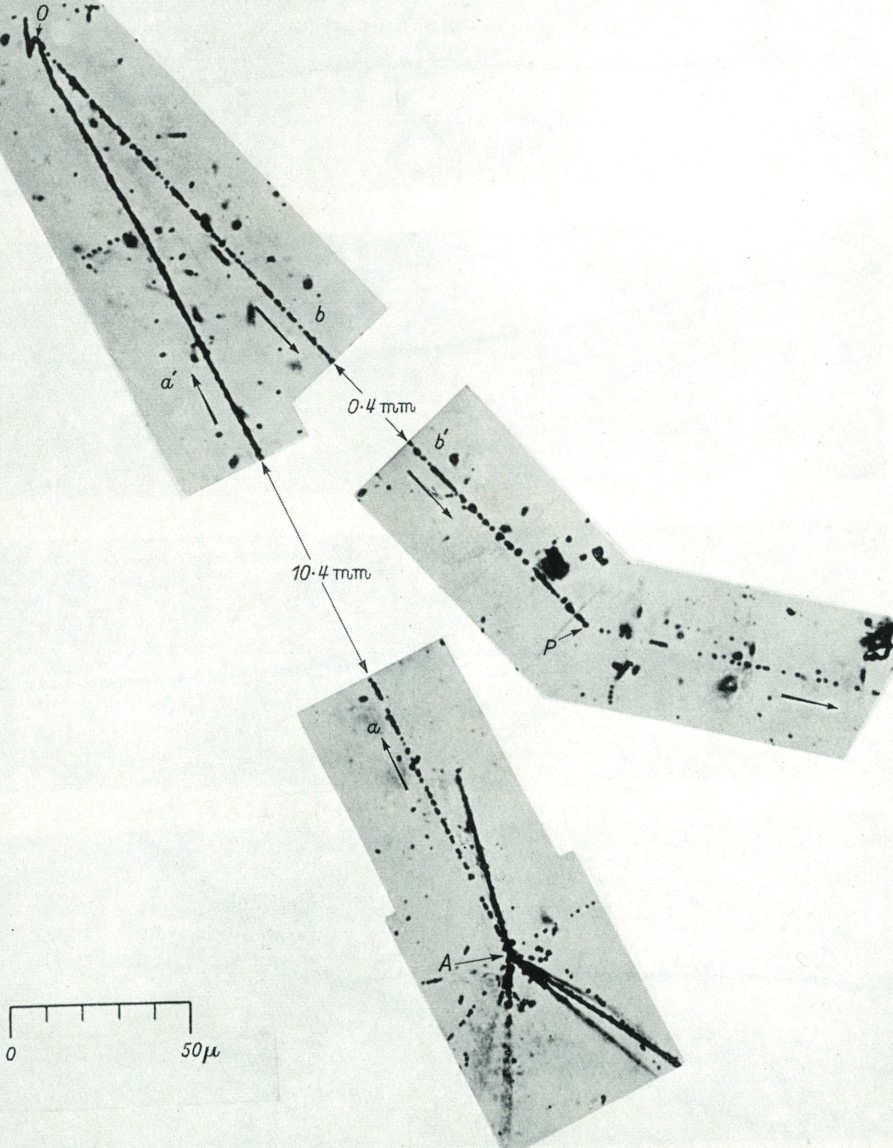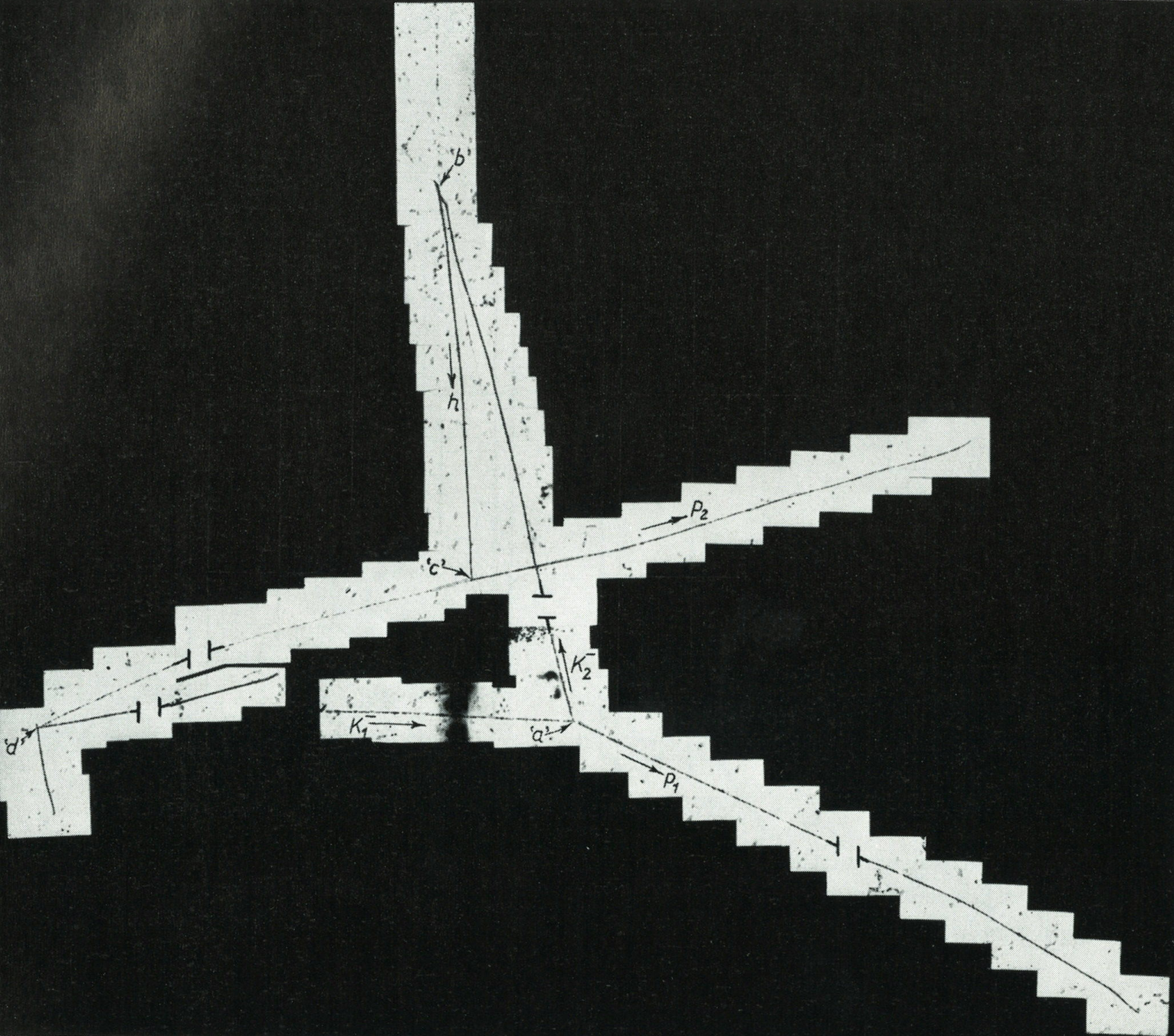In nuclear collisions of π and protons of high energy, Kaons are produced, both charged and neutral, with masses equal to 966 me. These particles can then decay into a variety of modes (and much more) :

The first indication of the existence of the Kaons was found by Leprince-Ringuet and L’Héritier (1944) who observed a charged particle in a Wilson cloud chamber which collided with an electron. An analysis of the dynamics of the collision led them to the conclusion that the mass of the incident particle was ∼1000 me. Later in 1947, Rochester and Butler found two forked tracks that they interpreted them as the decay ‘in flight’ of two particles, each with mass about 1000 me, one charged and the other neutral (lambda particle). In 1948, Leprince-Ringuet observed in an emulsion a particle which reached the end of its range ; a nuclear disintegration occurred from which a π- of low range (200 μm, about 2,5 MeV) was emitted. The following years, the others mode of decay of Kaons was observed in emulsions.
Example of direct production of K in nuclear disintegrations
Bottom picture (1954) : At A, a nuclear disintegration emits a K+ which reach the end of its range at O and decay into a π+which have about 41 MeV of kinetic energy. It then decay into a muon, which is heavily scattered at point Q, as a result of Coulomb forces in a collision with a nucleus of the emulsion (Ag, Br, C..). The muon then decay into a β particle.
K±→ π± + π++ π– (branching ratio 5.6% )
Left picture : First observation (1949) of the reaction K+→ π+ + π++ π–. Jungfraujoch under 10 cm of lead. The mass of the incoming particle (τ) is determined by measuring the grain-density and scattering along the track. A slow particle (a) emerges from the end of the range of the parent Kaon (τ) at A, and comes to rest at B where it produces a nuclear disintegration characteristic of a π particle. Tracks b and c are π+ with 33 and 31 MeV of kinetic energy. The π– particle (a) (as it makes a nuclear disintegration) has about 1 MeV of kinetic energy.
Following this observation, it was more than a year and a half before a second example was found and by July 1953, the number had increased only to twelve. Although Kaons decaying into three charged π occurred rarely, it was easy to identify because of the following features of the tracks : when a kaon moves through a solid substance, it is commonly brought to rest before decaying. The three charged π into which it transforms are therefore emitted in directions which are co-planar. The directions of motions of theses particles and their velocities (which may be determined by the grain-density in the tracks) must be consistent with the assumption that if the secondary particles are of equal mass, their resultant momentum is zero. The Q value of this mode of decay is about 76 MeV.
Above pictures. A : Jungfraujoch under 30 cm of lead (1951) . B : Jungfraujoch in glacier (1951) . The parent particle undergo a large angle scattering near the centre of disintegration. C : Mt Rosa under 6 cm of aluminium (1952) . D : Balloon flight at 90.000 ft, no absorber (1952). The marked scattering of the Kaon at points near the centre of disintegration is an evidence that the particle was approaching the end of its range.
It was found in 1953 that almost all the Kaon, after being arrested in the emulsion are positive. K– in this mode of disintegration, rarely decay at rest but most often decay in flight or is captured by nuclei (like negative muon & pion). This K– capture process frequently leads to the emission of a π, and little energy appears in the form of ejected proton, α-particles and other evaporated nucleons (neutrons).
Bottom picture (1953) : The Kaon reaches the end of its range at the point P and decays into three particles of which the initial directions of motion are co-planar. One of the three secondary particles stops at Q and emits a μ which in turn decays, at the point R, into an electron.
Bottom picture (1953) : This event provided the first evidence for the direct production of Kaon in nuclear disintegrations. The Kaon emerges from a nuclear encounter in the emulsion at the point O, and stops in the emulsion at the point P, its total range being ~ 7 mm.
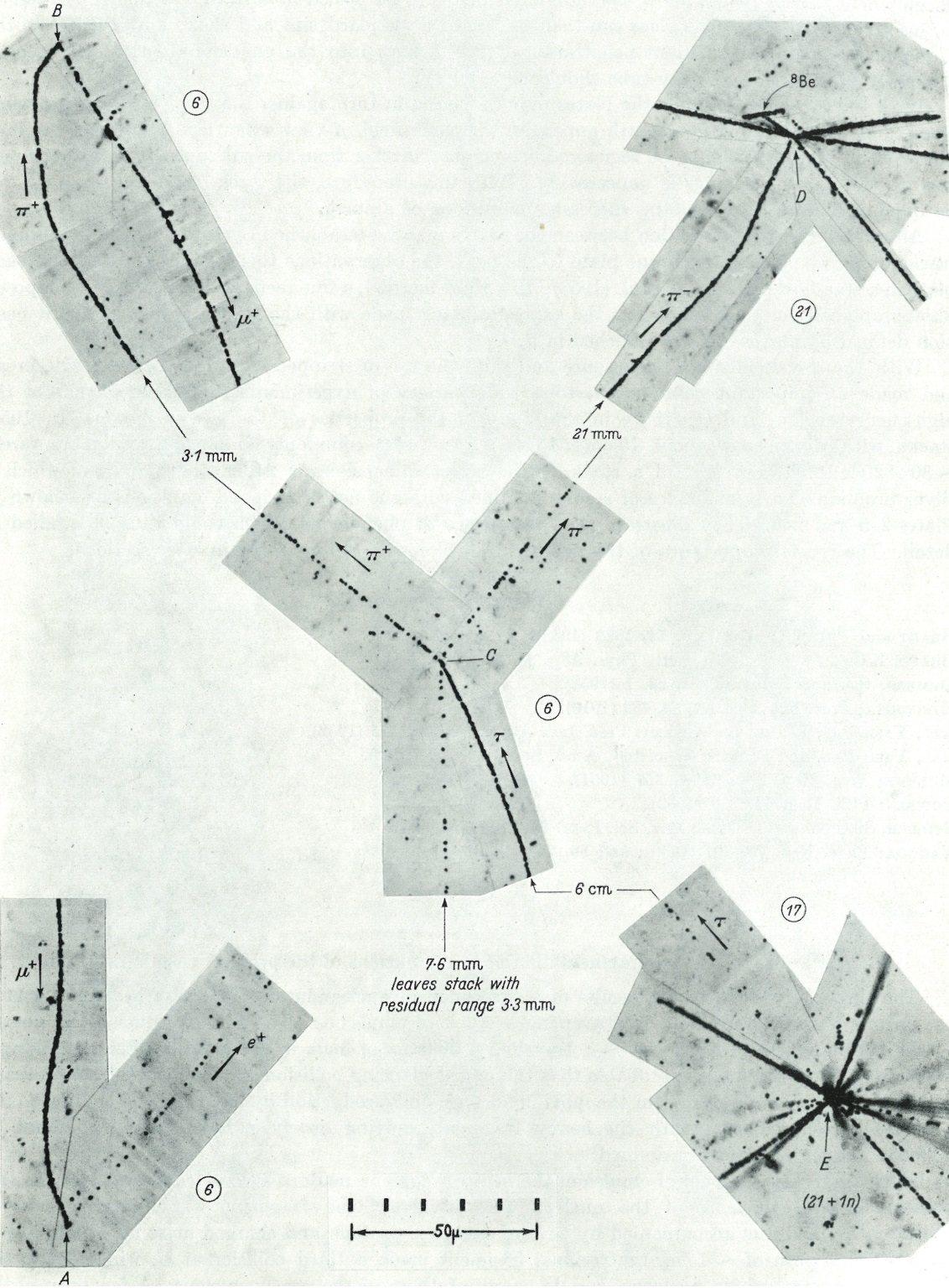
Left picture : The observations were made in 1952 in a stack of 46 emulsions each 15 x 15 cm exposed at high altitude over Southern England. The number in the stack of the plate in which a particular event occurred, is shown ringed. The first observation was of the decay at A of a μ into an electron. On following back the muon, it was found to have been produced by the decay of a pion at B in the same plate, n°6. On following back the pion in turn, it was found to have originated in the decay of a Kaon at point C. This Kaon originated in a nuclear disintegration at the point E, where 21 secondary particles are emitted. Theses particles from this disintegration were followed to the end of their range in the stack, or to their point of escape, but none of them showed any remarkable features. At the magnification employed in the photographs, the distance between the points E and C in the plate would be about 40 m in air.
The energy of the three π particles formed by the decay of the Kaon were 12 ; 26 and 38 MeV. The total release of energy was therefore 76 MeV.
One of the π formed by the decay of the Kaon reach the point D in plate n°21, where it produced a nuclear disintegration. Among the secondary products of this disintegration there were four singly charged particle and a 8Li3 nucleus. The latter, on reaching the end of its range, suffered β-decay with the formation of a 8Be4 nucleus in an excited state. This nucleus then disintegrated spontaneously into two α-particles. The resulting ‘hammer’ tracks are due to the α-particles which recoiled from one another with equal and opposite momenta. The characteristics (see here, method n°2) of the disintegration produced by the π– at D are such that the parent nucleus must have been one of the light elements in the emulsion, carbon, nitrogen or oxygen. Since the total charge of the secondary particles is at least (3+4)e=7e, the charge of the original nucleus must have been 8e, i.e oxygen (prior to the collision the total charge was -1(pion) + 8 =7, identical to the final state).
K→ μ + π0 +υμ (branching ratio 3.3% )
Bottom picture (1954) : Measurements of scattering and grain-density show that the secondary particle was a muon ejected with an energy ~34 MeV. The track of the primary particle (Kaon) was 1,5 mm long. Despite the π0 particles can’t be recorded in the emulsion, we know that this event belong to this reaction because the energy measured on the muon is low. For this reaction, the muon can have an energy from 0 to a maximum of 134 MeV. The rest of energy is shared between the two other neutral particles.
Bottom picture (1953) : Direct production of a Kaon. One of the first event of this kind to be recorded in plate exposed in a balloon flight of 4 hours at an altitude of 27 km height. A Kaon of range 14 mm is ejected from a nuclear disintegration at A and reaches the end of its range at the point B where it disintegrates. The secondary particle is a muon of energy 80 MeV showing that the Kaon decayed in this mode.
Fates of K– and K+ after their production
Like stated with the negative pion and muon, it’s unlikely to observe the decay of such negative particles in flight. They are captured by a nucleus, which then disintegrate into protons, deuton triton or alpha particles to dissipate the excess of energy. In 1952-1954, many events of Kaon decaying in flight (according to the different modes) were recorded. But very few example of nucleus disintegration induced by the capture of a negative Kaon was recorded. These results suggested either a) that there is a large excess of positive Kaon emitted from the nuclear disintegrations produced by cosmic radiation ; or b) that some of the negative particles decay at the end of their range before interacting with a nucleus ; or c) that the characteristics of the nuclear interactions are such that the number of secondary particles is few or none, and the events are correspondingly difficult to detect.
That there is indeed a large preponderance of K+ particles which decays at the end of their range after being created in a nuclear disintegration, was proved by experiment by Dahanayake in 1955. They measured the mass of about 2400 particles emitted from nuclear disintegrations with velocities between 0,2c and 0,5c. In addition to 1700 protons, 450 deuterons, 150 tritons and a few α-particles, they found 50 π and 11 Kaons, all of which decayed at the end of their range into a single secondary charged particle. At the same time, Fowler investigated secondary particles of higher velocity 0,5c to 0,8c. Amongst 304 protons, 21 deuterons, 2 hyperons 2 tritons and 150 pions, they observed 8 Kaons, of which 3 were brought to rest ; all of these decayed and one in the τ mode (production of 3 π). Although the sign of the charge of the individual Kaon produced by cosmic which decay at rest in photographic plates can rarely by established, evidence that there are very few negative particles among them, or none, was provided by the absence of any associated Auger electron (see here). Such an electron is sometimes found associated with the nuclear interaction of a K– (same process than π– or μ– nucleus capture).
Some example of K– capture was found in 1954. Picture below, the scattering of the particle ‘a’ showed that it was inferior to the scattering of a Pion. The particle was traced back to the parent star ‘P’ and its measured mass was found to be 970 me, consistant with the mass of a Kaon. The Kaon is captured by a nucleus at O, which disintegrate. But only a small fraction of the available energy (rest mass of the Kaon) appears among the charged products of the disintegration…
With the widespread use of stacks of emulsion, new examples of disintegrations due to the nuclear capture of negative kaon were discovered (example above). It was soon found that the total visible release of kinetic energy from the disintegrations produced by K–, as shown by the energy of the secondary charged particles, is less than might be expected to follow from the release of ~470 MeV/c² among the nucleons of a nucleus. From the 12 disintegrations observed, protons and α particles only were emitted in four events, in three of which one of the protons was of high energy about 100 MeV (example below).
In seven examples, fast π were produced, generally accompanied by ‘evaporation’ protons and α particles, the energy of the pion falling in the interval between 27 and 54 MeV ; and in two events, charged hyperons Σ (Sigma particle) were emitted !
In view of the rarity of examples of the nuclear interaction of K– in emulsions exposed to cosmic radiation, some accelerators were used to produce artificially beam of K–. It was found that the Kaon interact with a free proton or with a neutron with these reactions :
The hyperon Σ (Sigma) have a rest mass about 1100 MeV/c², almost twice of the Kaon, which explain why some of the rest mass energy of the Kaon was not fully shared among the charged secondary particle. The first event to be observed, in which a charged hyperon is emitted from a disintegration produced by the nuclear interaction of a K– at the end of its range (O) is reproduced below. The hyperon decays, at the point P, into a secondary particle assumed to be a pion. The short track from O heavily scattered cannot be identified.
Other example of interaction of a K–
In the next picture, a negative Kaon (K1) interacts with a proton at the point ‘a’ and projects it, track p1, and itself recoils, coming to the end of its range at ‘b’. Following the capture of the K– by the nucleus of a light element in the emulsion, four charged secondary particles result (2 going upward, a discrete one going downward and track ‘h’). The hyperfragment ‘h’ is probably an α or He5 which reaches the end of its range at ‘c’ and there decays into a very short range proton p2 and a π which is captured by a nucleus at ‘d’.
